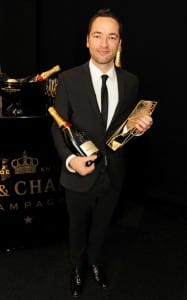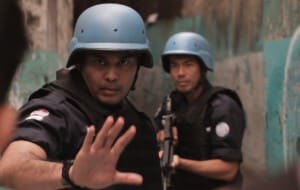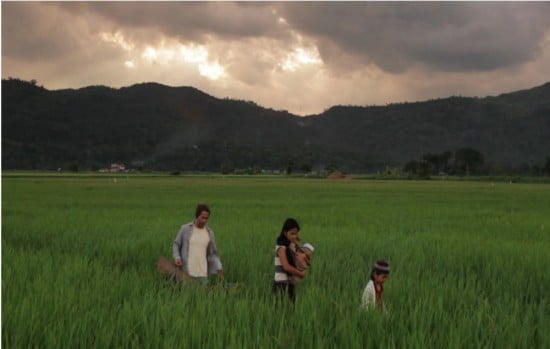Whilst on holiday in the Philippines in 2007, British filmmaker Sean Ellis witnessed the two drivers of an armoured truck having an argument. As Ellis explains: ‘They had M16s and guns, and looked like they were going to shoot each other. It ended with one of them kicking the truck, getting in and driving off. And I started to think that it could be a scene from a movie’. Developing the idea from there, Ellis’ imaginary movie became his third feature film, Metro Manila, a ‘slowburn thriller’ about the events that transpire after Oscar (Jake Macapagal) moves to Metro Manila from the provinces, in search of a better life.
Alex Barrett spoke to Ellis and Macapagal about the making of the film.
AB: Sean, what was it like for you working in the Philippines? I don’t necessarily mean practically, but as someone that’s effectively an outsider coming in – what was that experience like, and how did that effect the way you directed the film?
SE: There was some weird ‘reverse racism’, as they call it. And it is weird. Some people won’t work with you because you’re white, and they expect to be paid American fees, and it was like ‘well, this film is in Tagalog, it’s not an American film’. So [it was hard] just to get people to take me as one of their own, and pretend that I was Filipino. And the heat was pretty difficult. Very oppressive.
JM: Humid.
SE: Trying to work – carrying cameras all day – it’s kind of tough.
JM: I think the challenge is also the bureaucracy. You have to know a lot of people in the government and the community, so you can pay them off and get licences. And if you don’t get the licence, you can just shoot guerrilla style. So those are the challenges, but at the same time, it’s pretty exciting because, you know, everyone was excited to shoot with Sean.
 AB: And what was that like for you, having someone who is an outsider come in?
AB: And what was that like for you, having someone who is an outsider come in?
JM: It didn’t… I’ve worked here in the UK, I’ve worked in international productions. Sean just happened to be British. I got on with him since the first time we met each other. I really respected his vision and his love of cinema. And you can tell, because he gives you that space to…[turns to Sean] I’m talking like you’re not here [laughs]. He gave me the space to just discuss things and develop the character, and just try to deal with the journey. The first question he asked me after he offered me the role was ‘are you willing to take the journey with me?’ Which was pretty exciting.
AB: Sean, you’ve spoken elsewhere about your desire to bring authenticity to the project, and I’m wondering how you went about trying to get that. Did you do research? Did you spend a lot of time there? And Jake, were you able help Sean bring that authenticity to the project?
SE: It was definitely an organic process, and being immersed into the culture you can’t help but take everything that you’re seeing and try and use it in some respect. And I think what’s interesting about a Westerner going to the Philippines is that they would see things that Filipinos just take for granted and see every day. I was very open to seeing these things for the very first time and using them.
JM: We were discussing that a lot of times. The thing with Sean is that he’s like a curious kid, you know? The way they think, the way they go in this direction and that direction…that’s what we did.
AB: The real-life story of Reginald Chua is integrated into the narrative of the film. How did you come across that story, and what did that blend of fact and fiction mean for the project?
SE: Well, in the first two weeks I was there I was doing the preproduction for the film, and I was immersing myself into the Filipino culture. I was doing a lot of research, and meeting a lot of people, talking about their lives and how it all related to the script, trying by osmosis to bring that authenticity into the project, and I met with a director called Quark Henares, who’s actually become a friend of mine. Quark said ‘it’s a similar situation to this Reginald Chua’, so I said ‘who’s that?’, and he said ‘oh, you know, this desperate guy, caught in a bad place, who ended up robbing a plane, taking everyone’s money and jumping off using a parachute from his father’s silk factory’…
JM: A homemade parachute.
SE: I found this article online and I read it and the last paragraph of it said ‘Reginald was found four days later buried up to his waist in mud surrounded by money, with the silk parachute of his father’s factory bellowing in the wind behind him’. I was so struck by that image that I couldn’t help but put that in the film. It felt like a bookend to me, so I bookended the film with this image, and used it as a parallel fable to explain some of Oscar’s backstory, and also as a way of sort of tying up his climax in the third act. You know, the fact that Oscar has learnt quite a lot from Reginald, or as we call him Alfred Santos. Alfred was in a similar situation but hadn’t thought it all the way through to the end, whereas I think Oscar learnt from that and thought it out through to the end.
AB: Jake, how did the incorporation of factual elements help you with the development of your character, and the way you approached building that role?
JM: Most of my characterisation was just really based on… I just imagined myself in that situation. And I think it’s something that most Filipinos experience. I know how it is to have no money. And as an actor as well, you wait on jobs. But I sort of just put myself in the situation. I mean, I don’t have to look very far. It’s in my neighbourhood, it’s out there in the streets. You know, people wake up and the only thing they think about is what they’re going eat that day. This is – and I’m not blind to that – part of our Metro Manila, of our society. So I just took it all in. When we went to the slums, my first reaction was ‘how can anyone survive that?’, but then eventually you get used to it and you think ‘oh yeah, this is the way they live’. You don’t have to do method for that.
SE: I was quite struck by actually how big hearted the people of the slums were and how generous they were, and actually, weirdly, weirdly, how happy they were.
JM: Yeah, it’s really odd.
SE: I’m not saying that’s the secret to life, but what I’m saying is that, when you have nothing, life is very simple, you know? Like Jake said, your needs are ‘find food for that day’, you’re not worrying about updating your fucking Facebook account, or who said this or this promotion, or whatever.
JM: Living for the moment, they just live for the moment.
SE: It’s just very simple. They live very much in the moment. There’s an honesty to that, and it’s actually a very beautiful thing when you meet people that live very much in the moment. So it was a very joyful time to actually spend with those people. They were excited, weren’t they?
JM: All the kids were following you around, right? I mean, it made us comfortable, gave us a comfortable atmosphere.
AB: Sean, I wanted to ask you: one of the things I thought was quite extraordinary about the film is the lyricism that it has – it’s almost meditative. But when you actually look at it, it’s very quickly cut and the shots are very short. So I was interested in how you were able to strike upon that kind of pacing, where it’s very quickly cut, but also very lyrical. And I was wondering if it was planned, or if it was found in the edit room?
SE: You have to remember that this is a film that’s been designed as a subtitled film. It’s not a foreign film that then has subtitles slapped on it after the edit is finished. So it was very much part of the process of being able to cut the film, knowing that people would be reading what you put up on the screen as a subtitle, which then meant that once it disappears their eyes go back to the image. And once their eyes go back to the image, that’s when you give them the information or the detail that they need to see. And then when the character starts speaking again, then they’re drawn away from what’s happening on the screen to reread the subtitles. So we were very conscious that we were making a film where you would be reading subtitles, and that did affect the structure and the approach to the edit. It is a pretty furious edit. I mean, there is a lot of detail in it, there’s a lot of quick cuts away to detailed stuff. And we did a lot of coverage on this, as opposed to some of my other films which were very stagnated and still. But I think what happens when you have quite a fast edit, when you suddenly don’t cut, the audience notices it. When they’re actually on one shot for quite a long time, it becomes elongated time, in some respects, you’re sort of like…It’s like a dance, you’re going quick, quick, slow. Quick, quick, slow. And I guess that gives it that lyricism that you’re seeing.
AB: I think the lyricism also comes from the cinematography. We don’t have much time left, but could you maybe talk quickly about the way you approached the cinematography, and the lighting especially?
SE: We didn’t have a great resource of equipment. We didn’t have much time. So my approach was documentary style filmmaking. And the two reasons being: first of all, it’s very quick, and you can move very fast, and you can get a lot of coverage that way. And secondly, it gives you the code of documentary filmmaking – so it added a realism to the fiction, because you’re used to seeing documentarians finding their focus and being handheld, and this gave the family [in Metro Manila] a sense of realism, I believe. You felt you were actually following a documentary of a family migrating from the provinces to the city. So it’s sort of a two-fold, two-pronged attack.
AB: Jake, could you talk about how it was for you to act within this documentary approach? Do you think it helped your performance?
JM: Yeah, because you feel like you’re not conscious of the camera. I mean, it’s just following us on the journey. And the more you spend time with that, with Sean, you can just get used to that. As an actor, your job is to get to the objective and understand what the director is trying to get you to do, to move from A to B. So as an actor, I just concentrate on what it is he wants, which is great when it’s someone following you around with the camera. You can trust that.
SE: It also meant a lot less stopping and starting.
JM: Yeah.
SE: There’s a lot of waiting around on film sets normally, but we were pretty furious with what we were doing, so Jake didn’t have much time to sit around and get pedicures. [Laughs].
JM: Yeah, no time for that. I suppose as well it’s like the rote memory way, when you just keep on doing it. I don’t know if Sean was doing that consciously, but the way he does it, you don’t think anymore, until you get the right balance, and he says ‘okay that’s right’.
SE: I have a bad habit, actually, of talking while they’re acting.
JM: But it’s kind of good, in a way, because you know that you’re doing ok. You don’t … Because the camera will pick up if there’s a doubt in your eyes. ‘Am I doing this right?’ – the camera will pick it up. But if one hears ‘okay, that’s good, can I get one more’, it gives you a guide that’s useful to follow.
SE: You know, it’s all ‘just go back two words’, ‘say those two words again’, ‘just do it again’, ‘go back three words’.
JM: Yeah, yeah.
SE: I think it just drums out any notion of, like, ‘now act’, because you’re redoing redoing it, redoing redoing it. Breaking it down, you know?
JM: And maybe because you get tired, all of a sudden you’re just less conscious, and then [claps hands] that’s what he wants.
AB: Unfortunately it looks like we’re out of time, but thank you very much.
JM: Thanks.
SE: Thank you.
METRO MANILA won BEST FILM at the BEST INDEPENDENT FILM AWARDS, SEAN ELLIS WON BEST DIRECTOR AND THE FILM IS BRITAIN’S SUBMISSION TO THE ACADEMY AWARDS 2014



